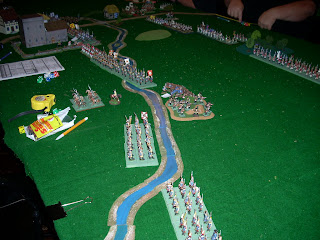As the cavalry was battling to and fro off on the flank and Phil's Imperium brigade was tangling with the Brittanians in and around the woods, the rest of the Imperium army continued their advance against the Electoral defenses around the cannon foundry.
As usual, please click on the pictures to see a larger image. Photo by Bill Hamilton
Photo by Bill HamiltonJohn Murdaugh's brigade of Imperium and Reichsarmee battalions advances towards the Eisenmuhlen Regiment defending their cannon foundry.
 Photo by Bill Hamilton
Photo by Bill HamiltonAcross the road to their right, Mark Stevens' Courland and Sachsen-Wachsenstein grenadiers advance forced the Carpanian jagers to give up the outlying farm after a token resistance. After all, if you were a jager would you want to tangle with grenadiers?
 Photo by Jim Pitts
Photo by Jim PittsAnd to the left of John's brigade, Clay James continued to advance his brigade of Courland and Sachsen-Wachsenstein infantry on the Imperium's left flank.
 Photo by Ed Sansing
Photo by Ed SansingThe might of the Imperium army gets closer to the Electoral defenses.
 Photo by Ed Sansing
Photo by Ed SansingMeanwhile, Larry Reeves, on the Electoral right, adjusts his Carpanian defenders while the Britannian light dragoons and Carpanian jagers regroup behind him.
 Photo by Ed Sansing
Photo by Ed SansingAnd the cavalry melee continues into a second round while the Imperium infantry gets ready to attack the Brittanians in the woods.
 Photo by Jim Pitts
Photo by Jim PittsWhile all this was happening, Mark Stevens consolidated his army's heavy artillery on a small hill to begin bombarding the Electoral defenders around the cannon foundry. A Courland 12-lbr is in the foreground, with a Courland 20-lb licorne in the center and a Sachsen-Wachsenstein 8-lbr on the other end of the gun line.
 Photo by Ed Sansing
Photo by Ed SansingMark's Courland grenadiers get ready to cross the hedge around the farm yard.
 Photo by Ed Sansing
Photo by Ed SansingThe Electoral defenders await the initial onslaught of the Imperium forces. In the foreground are some of the newly cast guns from the foundry, while to their rear a company of Carpanian jagers regroups after the light troops battle earlier in the game.
 Photo by Ed Sansing
Photo by Ed SansingThe Courland Constantine Horse (left) is getting the worst of its melee with a squadron of the Carpanian Hapnich Dragoons. It will soon fall back, followed by the Carpanians. In the background, the Reichsarmee troops have inflicted some losses on the Brittanians defending the woods.
 Photo by Bill Hamilton
Photo by Bill Hamilton The Reichsarmee and Courland/Sachsen briagdes haven't made much progress in their attack. Could the Electoral defenses look too formidable?
 Photo by Ed Sansing
Photo by Ed SansingBut finally Clay's Courland and Sachsen-Wachsenstein battalions begin to put pressure on Larry's Carpanians, forcing some of them back across the stream. Ed Sansing has moved a company of Carpanian jagers to screen the far right flank of Larry's line.
 Photo by Bill Hamilton
Photo by Bill HamiltonAs John Murdaugh's Reichsarmee battalions begin their assault in the background, the rest of the Electoral line still awaits the Courland grenadiers. But they seem to be moving very slowly.
 Photo by Ed Sansing
Photo by Ed SansingAnd here's the reason - they have been taking casualties from the Electoral artillery and appear not to want to give up the scant protection of the farm yard hedges.
 Photo by Ed Sansing
Photo by Ed SansingAt the end of the battle, Mark Stevens, the Imperium commander, takes a close-up look at the Carpanians of Larry Reeves brigade. In this picture you can also see how close some of John Murdaugh's Reichsarmee battalions got, and the casualties they took doing so.
The battle was deemed a draw by the umpire (yours truly). Although the Imperium had failed to take the cannon foundry, they were in good positions to outflank it.
This was the second actual battle we had using Bill Protz's Batailles de l'Ancien Regime rules. I'm sure there are some things we didn't do quite correctly, but it appeared that everyone had a good time and seemed to master some of the intracacies of 18th Century battle field maneuvering.
Lessons Learned: First of all, I would not have a light troops battle before the main affair. It took up too much time and didn't really affect the battle. Secondly, as in the first battle, I should have already had the armies set up and allowed only a small amount of adjustment before the start. Thirdly, the Carpanians had too many guns and their defenses were very strong. The Imperium troops would have been hard pressed to actually break into the cannon foundry grounds if the battle had gotten that far.
Although we won't have any more battles this campaigning season, you can look forward to some more in 1760/2010.
























































